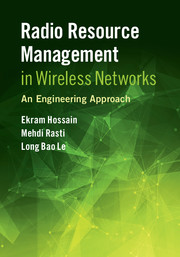Book contents
- Frontmatter
- Contents
- Preface
- Part I Basics of Wireless Networks
- Part II Techniques for Modeling and Analysis of Radio Resource Allocation Methods in Wireless Networks
- Part III Physical Layer Resource Allocation in Wireless Networks
- Part IV Link Layer Resource Allocation in Wireless Networks
- 10 Sub-Carrier/Sub-Channel Allocation in OFDMA Networks
- 11 Resource Allocation in Relay-Based Networks
- 12 Channel Allocation for Infrastructure-Based 802.11 WLANs
- Part V Cross-Layer Modeling for Resource Allocation in Wireless Networks
- Index
- References
12 - Channel Allocation for Infrastructure-Based 802.11 WLANs
from Part IV - Link Layer Resource Allocation in Wireless Networks
Published online by Cambridge University Press: 11 May 2017
- Frontmatter
- Contents
- Preface
- Part I Basics of Wireless Networks
- Part II Techniques for Modeling and Analysis of Radio Resource Allocation Methods in Wireless Networks
- Part III Physical Layer Resource Allocation in Wireless Networks
- Part IV Link Layer Resource Allocation in Wireless Networks
- 10 Sub-Carrier/Sub-Channel Allocation in OFDMA Networks
- 11 Resource Allocation in Relay-Based Networks
- 12 Channel Allocation for Infrastructure-Based 802.11 WLANs
- Part V Cross-Layer Modeling for Resource Allocation in Wireless Networks
- Index
- References
Summary
Introduction
Due primarily to its unlicensed frequency band of operation and low-cost equipment, the IEEE 802.11-based wireless access technology, also known as WiFi, has been widely deployed in local area networks (LANs). A typical deployment of this technology is shown in Figure 12.1. Based on how they are managed, wireless LANs (WLANs) can be categorized into one of the following: (1) Centrally managed or (2) Uncoordinated [2]. Centrally managed deployments are usually seen in places such as university campuses, offices, or airports where all access points (APs) and associated clients are managed by a central entity. On the other hand, uncoordinated WLANs operate in the absence of a central control and are typical in places such as residential neighborhoods or private hotspots managed by different service providers (e.g., restaurants, coffee shops, etc.).
Successful deployment in either case requires efficient mechanisms for addressing performance issues such as excessive interference, which usually translates into low throughputs. In the literature, several techniques have been proposed to address such performance issues. In particular, association control (or load balancing), in which a central entity associates (respectively, disassociates) clients with (respectively, from) APs in order to balance traffic in a network, is usually proposed for the centrally managed deployments [3]. Proposed for the uncoordinated deployments, on the other hand, are such techniques as power control [4] and careful carrier-sensing [5], in which transmission power is dynamically tuned and unnecessary carrier sensing is avoided, respectively. One other technique that is extensively considered and applicable to both centrally managed and uncoordinated environments is channel assignment, in which a frequency channel is assigned to each AP for use for a certain duration of time. In this chapter, we present a survey of such channel assignment techniques. We identify and discuss several major approaches applicable to the different deployment scenarios. Subsequently, a qualitative comparison is made among these approaches. Some comments on current practice in channel assignment are also presented. Finally, several important future research directions are outlined.
- Type
- Chapter
- Information
- Radio Resource Management in Wireless NetworksAn Engineering Approach, pp. 352 - 376Publisher: Cambridge University PressPrint publication year: 2017

